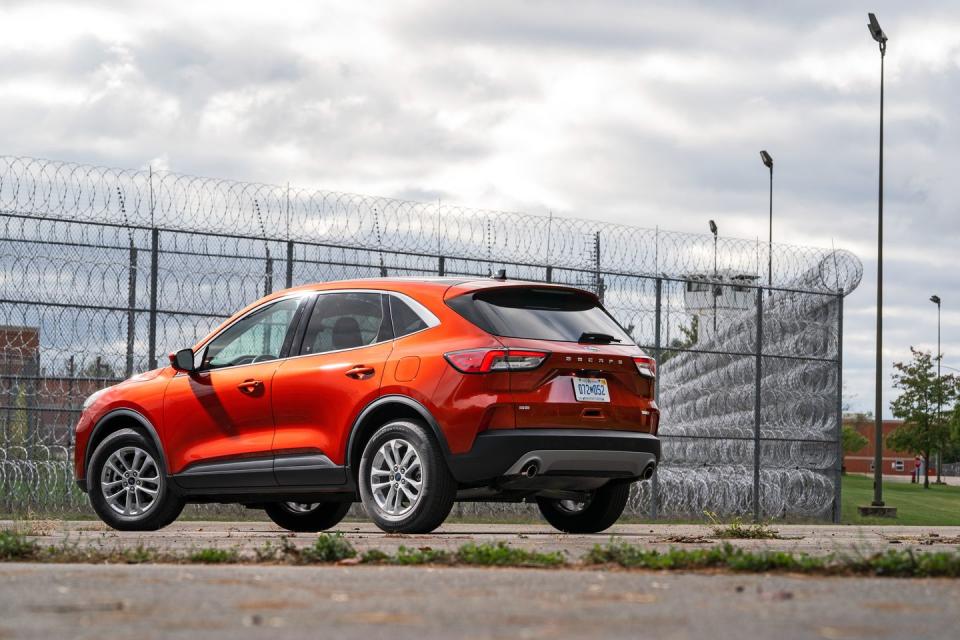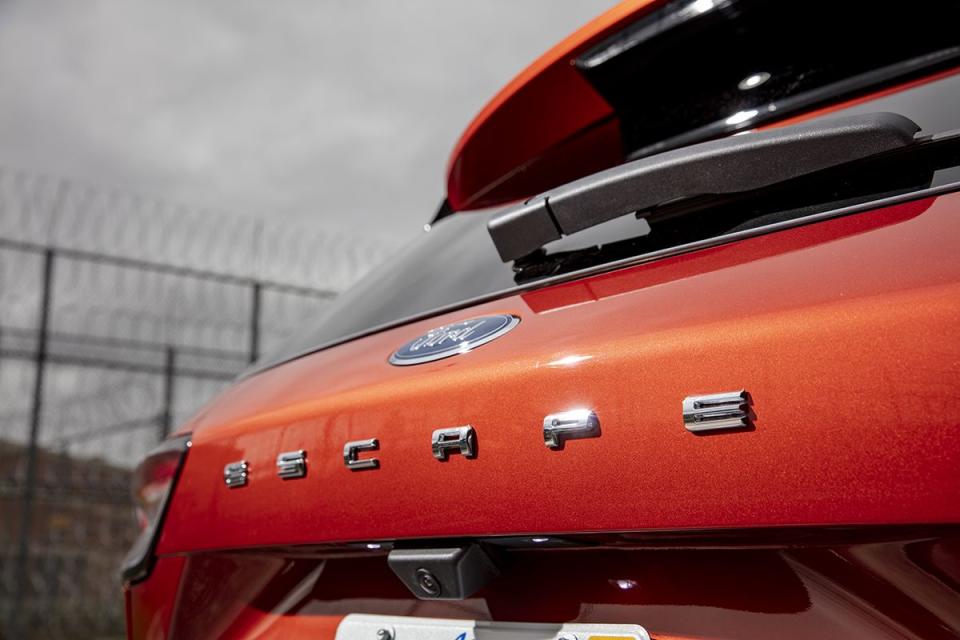Ford's New Escape Leaves a Bitter Aftertaste

We're all familiar with the concept: Your favorite restaurant revamps the menu, removing everything delicious and replacing it all with more expensive, less satisfying fare. "Come on in. You'll love our new menu!" Turns out this model isn't exclusive to eateries. It's also something automakers have glommed onto in recent months, most notably Ford. The company has largely gutted its U.S. lineup of affordable and enjoyable sedans and hatchbacks and packed it with crossovers. New look, same great taste!
If only. Ford's Fiesta and Focus, which are still sold in other parts of the world, are fun to drive, practical, and affordable. But without them in the U.S. fleet, Ford is hoping that first-time buyers will instead step into an EcoSport or Escape.

Part of the soaring popularity of these car-based crossovers is that they're not entry-level vehicles. They have the high seating position and rugged essence that people are willing to pay for. Oftentimes, these crossovers offer more features and greater refinement than the sedans and hatchbacks from which they are spawned. When Ford removed the bottom rung of its product ladder, it turned the Escape, its second-bestselling vehicle behind the F-150, into one the cheapest products in its portfolio—and we're not talking about price.
Our test car's interior has a modern design and a high-mounted infotainment touchscreen, but hard, shiny, and chintzy-looking plastics are everywhere. The cloth seats are attractive, featuring a diamond pattern on the inserts that's echoed on the Escape's door panels. There were some standout build-quality issues with our preproduction Escape: We could see a gap between the door trim and the fabric headliner, parts of the center console had sharp edges left over from the molding process, and one of the front speakers simply didn't work. The infotainment system, while attractive and intuitive, didn't always respond promptly. We can only hope that production versions will be screwed together with more care.

In the Escape hierarchy, our SE is one step up from the base trim, S. A turbocharged 1.5-liter inline-three making 181 horsepower and 190 pound-feet of torque is standard. SE Sport and Titanium models come with a hybridized 2.5-liter inline-four good for 200 horsepower, while the top-spec 250-hp turbo 2.0-liter is available on all-wheel-drive SEL and Titanium versions.
It's the smallest engine in the lineup, but the 1.5 is plenty potent. The turbo three moves this 3494-pound ute to 60 mph in 7.7 seconds, putting it near the top of its class. That time makes the Ford quicker than base-engine versions of the Hyundai Tucson, Mazda CX-5, Nissan Rogue, Subaru Forester, Toyota RAV4, and Volkswagen Tiguan. A Honda CR-V with a turbocharged 1.5-liter four is quicker, but not by much. But no CR-V can come close to an Escape packing the turbocharged 2.0-liter four; it hits 60 mph in only 5.7 seconds.
The 1.5-liter pairs well with the eight-speed automatic. We caught the transmission hunting between second, third, and fourth gears while creeping through a traffic jam. Despite being tuned to stay in high gears as much as possible to boost fuel economy, there's sufficient torque and power here to give the Escape a leg up on around-town traffic. The power figures and low-effort acceleration are pretty impressive for a 1.5-liter three-pot. At high speeds, though, like when flooring it onto a freeway, the engine feels a few horses short of satisfying. And the 75 decibels measured at full throttle might not be high, but the quality of the sound isn't pleasing. We also uncovered a bad vibration below 1250 rpm, and when Ford's cylinder-deactivation technology took the engine from three cylinders to two, a low boom reverberated through the cabin and could be felt in the floorpan.

The chassis tuning is dialed in to the right side of sporty, and the ride remained civil, even when our daily errands took us over washboard roads. The steering is direct, with good feel, firm weight, and no dead spots. And Ford has made standard in every Escape a suite of active safety technology, including automated emergency braking, blind-spot monitoring, and lane-keeping assistance. More safety features—such as adaptive cruise control, steering aid for evasive maneuvers, and automated parking capability—can be added, as Ford did with this car.
The cabin is spacious and airy thanks to the large windows. In back, there's an impressively roomy rear seat that can slide forward and back on a roughly six-inch track. The cargo hold is decent, too, with 34 cubic feet of space, and even this base powertrain is rated to tow up to 2000 pounds.
The all-wheel-drive system comes with several available modes, including one for sand—an uncommon setting in a car designed more for commuting than exploring. The Escape is handsome in a worn-in-bar-of-soap way. But its smooth edges and wide stance cut a less aggressive, less modern figure than the last gen's angular and chiseled body.

As is the case with many vehicles that visit our office, the Escape arrived without a price on its window sticker. Without that to go by, we assumed, based on the finish and content, that our test vehicle would ring in around $25,000. When we learned that this model—with its $1500 all-wheel drive and its adaptive cruise control and touchscreen navigation system (part of a $695 package)—cost $30,485, our acceptance turned into incredulity.
Given the inevitable lease deals and incentives, we hope no one will pay the MSRP for this or any other Escape. But we have to judge it on its as-tested price, and the Escape fights in a tough class filled with more refined and less expensive vehicles. The luxury-adjacent Mazda CX-5 can be had in its mid-tier Touring trim with all-wheel drive, leatherette seating, rain-sensing windshield wipers, and an engine with an even number of cylinders for less than $30,000. The Honda CR-V EX offers more power and a much better interior and costs less when comparably equipped. Toyota's RAV4 can be had in several trim levels (including with a hybrid powertrain) for less than our Escape SE, and adaptive cruise control comes standard.

Price is important at this end of the market, and $30,000 isn't a trivial sum. With nothing down and a five-year loan at 4 percent, this Escape would cost its owner almost $530 a month. Add insurance and the monthly bill will likely edge out of reach for households pulling in the median family income, which, in 2018, was $63,179. Stretching to own one seems like a big ask, and the folks who can afford it may be turned off by the obvious corner cutting.
The redesigned Escape makes it clear that rather than disappearing, Ford's budget-friendly compact cars have been transmuted into budget-unfriendly compact crossovers. One of the chief benefits of crossovers to car companies is that they tend to have higher profit margins than cars do. It makes sense that Ford would want to continue to capitalize on this by charging more for the Escape than any reasonable person would pay. That doesn't mean we should all play along.
From the December 2019 issue.
Tell us what you think. Write to: editors@caranddriver.com or join Backfires.caranddriver.com
You Might Also Like

 Yahoo News
Yahoo News 